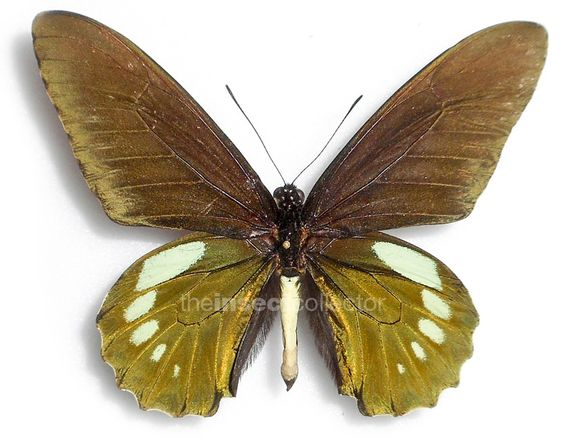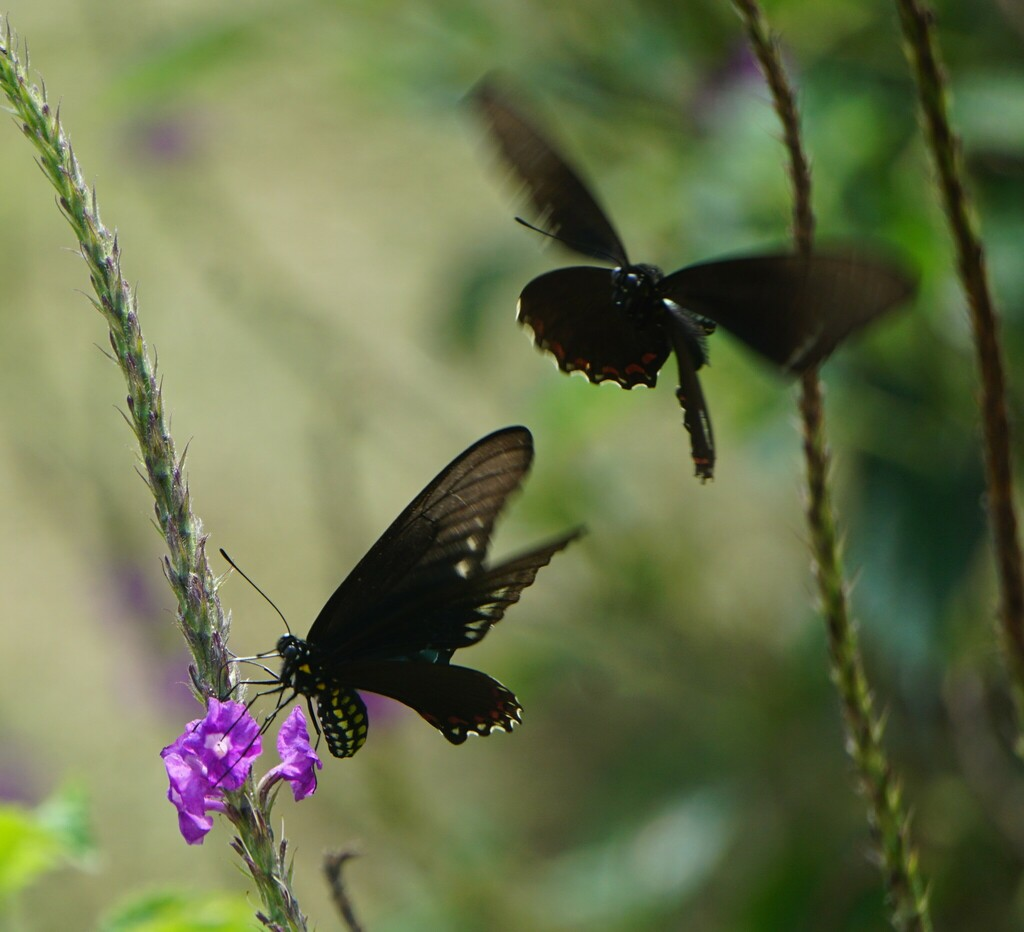Dyar's Swallowtail is also called the Confused Swallowtail and the East Mexican Swallowtail. It's easily confused with the West Mexican Swallowtail and other species in the genus Battus--which, of course, means that the naturalists are confused. The butterflies are not noticeably more confused than other butterflies; in some ways they may be "smarter" than some other Swallowtails. The Latin name, Battus ingenuus, could be translated as Inexperienced Swallowtail. The butterflies pack a lot of life experience--growing up, mating, reproducing, comfort, danger, old age and death-into a few weeks.
Confused naturalists tried a few other names for it, which haven't stuck. Of course it was placed in the genus Papilio, but other names proposed for this species included chalceus, latinus, and chrysomaculatus. It was sometimes considered a subspecies of B. belus.
The base color is black or blackish, more often seen as black-green in the male and dark brownish drab in the female. Even brownish females may seem to have an iridescent greenish sheen in the light, however. There is a pale green bar on the forward edge of the hind wing, and males' abdominal segments can be pale green, yellow, or white on top. Wingspread is about three and a half inches.
As with other Battus species, the hind wings are relatively small and the fore wings are relatively long, compared with other Swallowtails. At some angles they can look almost like Longwings.
Museum specimens can fade to olive:
Photo posted on Pinterest by theinsectcollector.com, a site that sells dead butterfly carcasses. We do not recommend paying for a dead butterfly or part of one. A collection of recognizable photos is much more of an accomplishment, and much more hygieniec to store in a house of library, and also unlikely to motivate a desperate person to kill the last of a rare subspecies for quick cash.
Jeffrey Glassberg's Swift Guide to Butterflies of Mexico and Central America contains a set of drawings designed to help visitors avoid confusing this Battus with other species in the genus, at least if the butterflies they see will sit still long enough to be compared with the drawings. If you happen to have an Internet connection when you spot one of these confusing animals on a hike, Renato Mattei has provided a four-photo montage that highlights the differences among males of four similar species:
Here's one of Glassberg's own out-takes. (The long fore wings are cut off.)
We could legally show all four photos here--it'd still be fair use--if we only knew how. The butterflies themselves, though probably able to admire each other's wing markings at close range, probably locate one another by scent. Male ingenuus' hind wings have scent folds, though human observers do not mention noticing a scent. Many moths and butterflies can home in on a scent, half a mile away, that humans don't notice when the individual actively summoning potential mates with its scent is perching on their collars.
Photo by Roland Rumm, whose subject is probably releasing a distress scent if butterflies have the abiity to release different scents. We don't know to what extent their scents broadcast their conditions ("I'm in danger," "I'm eating well,") or only their mating status "Male, never mated, heading this way," "Female, already mated, laying eggs").
Battus ingenuus is usually found at elevations about 3,000 feet above sea level. Associated with the east coast in Mexico, it is also found further south, in Central America through Ecuador and Venezeula, as far east as Trinidad island.
Dark coloring can serve as camouflage for bbutterflies when the climate is warm enough that the butterflies spend time in the shade. It is also a warning to predators. As with other Battus species, caterpillars eat vines in the genus Aristolochia and absorb enough aristolochic acid to make themselves toxic to birds for the rest of their lives.
But while the individual caterpillar's toxicity may protect his great-niece and great-great-great-grand-nephew, it will be too late for the individual caterpillar. Fortunately he has other defenses. Caterpillars don't survive by winning beauty contests, but by looking as unappetizing as possible. The harmless little warts growing in the brownish rings on this caterpillar have an unappealing dead-skin-yellow color tipped with black, like a thorny vine, or a lizard's grungy claws. Any animal that wanted to eat this little fellow would have to be very hungry indeed.
Josuergg photographed this courting couple in Honduras (in September). At this stage of their lives males and females are easy to recognize because the females are full of eggs. As they lay their eggs the females grow thinner.
Cirilo Umana has written a full-length study of the species' life cycle, in Spanish: https://www.acguanacaste.ac.cr/paginas-de-especies/insectos/113-papilionidae/793-i-battus-ingenuus-i-papilionidae . This paper is the source of some facts noted below.
Secure in its ugliness, a Battus ingenuus caterpillar crawls right down the upper side of a big leaf, rather than hiding on the underside as most caterpillars do, at https://www.facebook.com/100027321325005/videos/battus-ingenuus-dyar-1907-dyars-swallowtail-larva/354233375572191/ .
For a Swallowtail caterpillar this is probably one of the clearer-witted species. Some Swallowtail larvae eat their own shed skins, and, when they find another skin of their species, they want to eat that too and are not deterred by the fact that a sibling happens to be living in the other skin. The mother butterfly has to find a fresh plant to lay each egg on if she wants each egg to have a chance to hatch. Ingenuus have enough sense not to eat their siblings. Mother butterflies often lay several eggs on the underside of one leaf. Caterpillars can eat either Aristolochia maxima or Aristolochia tonduzii and will grow to about two inches long.
Photo by D.H. Janzen at butterfliesofamerica.org. Blackish when they hatch, the caterpillars reportedly molt from the black-and-brown striped phase shown above into a mostly pale tan pattern, then a mottled red-brown skin just before pupation. Umana sees their base color as purple, which can shade toward blue or brown.
Before pupating the caterpillar stops eating and assumes a prepupal position for up to three days, waiting to shed their last caterpillar skin and appear as pupas. Pupas are quite realistically detailed as dead leaves. They can be brown or green. Butterflies stay in the pupal shell for about eighteen days.
Generations overlap, and these butterflies are active all through the year. They are most often seen in August, with another population upsurge in December; they are least often seen in March and November, but a few individuals are active even then. Males are attracted to puddles and are often seen near trails that run through marshy areas.
Battus ingenuus is popular; several web sites list it among the attractions of parks, tours, and university study groups.









No comments:
Post a Comment